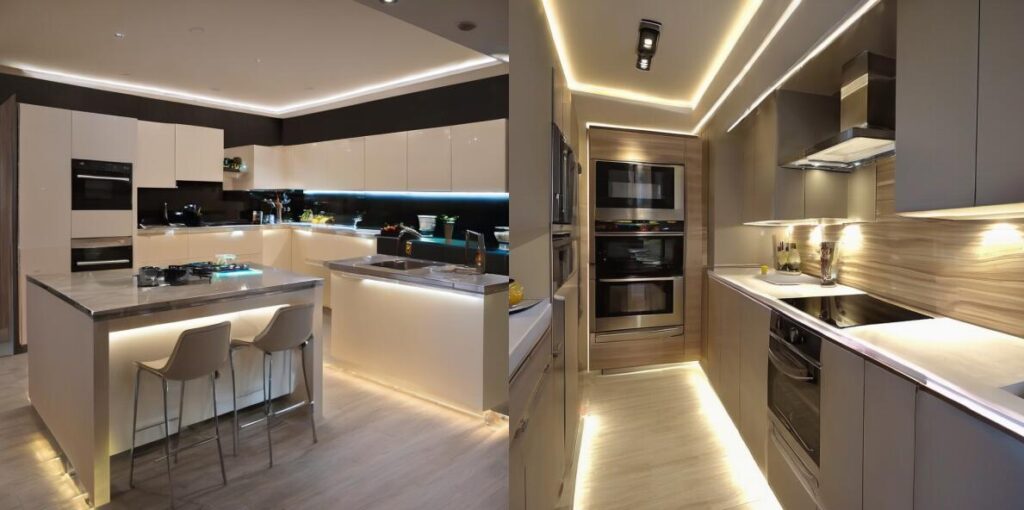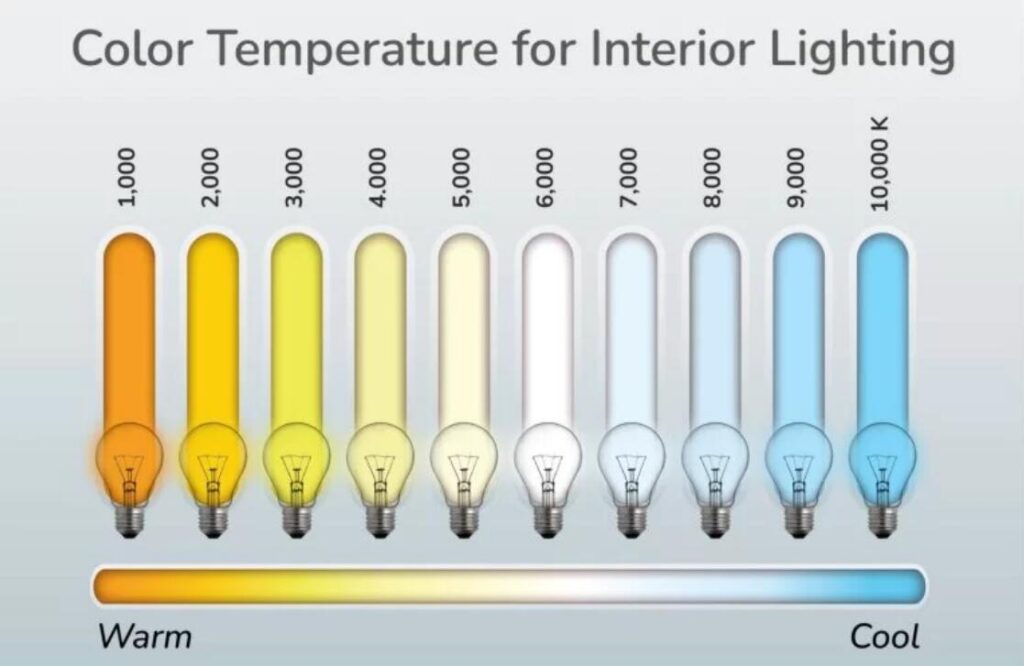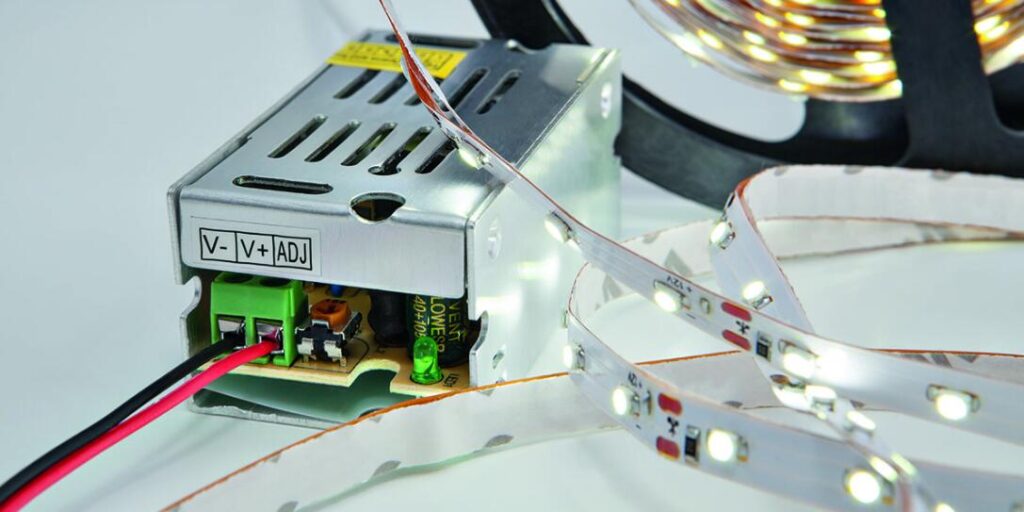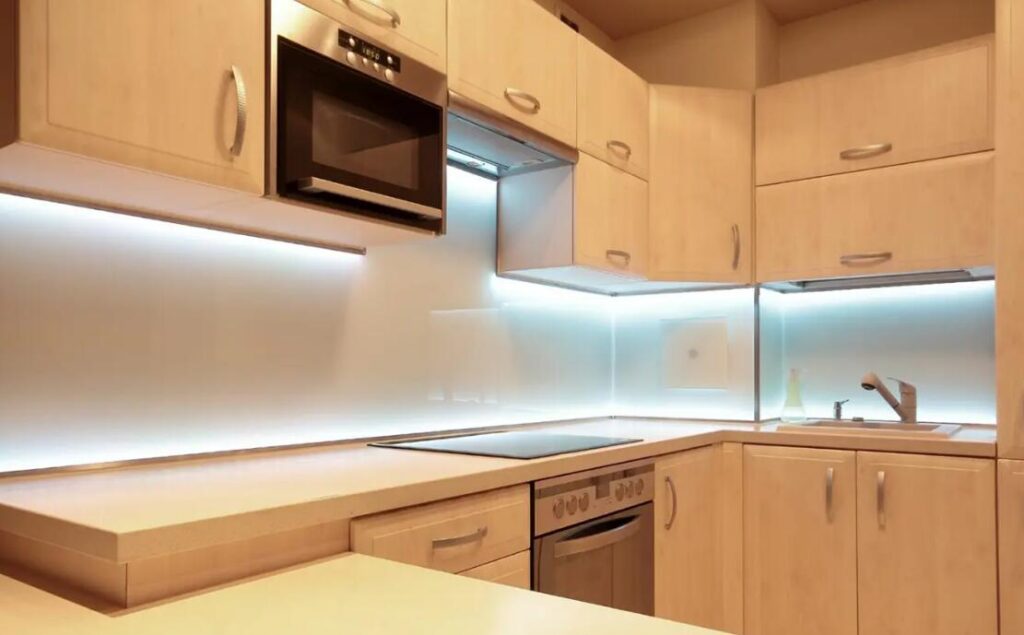
You’re stepping into your kitchen at night, and with a simple flick of a switch, your cabinets glow with a warm, inviting light that guides you effortlessly to what you need.
LED strip lights for kitchen cabinets can transform your space from ordinary to extraordinary, making it not only more functional but also more visually appealing.
But with so many options available, choosing the right LED strip lights can be a daunting task. Fear not! This guide will walk you through everything you need to know to make an informed decision.
Factors to Consider When Choosing LED Strip Lights for Kitchen Cabinets

Here are the key factors you need to consider when choosing the perfect LED strip lights for kitchen cabinets.
● Brightness Level

The brightness of LED strip lights is measured in lumens. For kitchen cabinets, you’ll want a strip light that provides enough illumination to make tasks like chopping, cooking, and cleaning easier. A good rule of thumb is to aim for a brightness level between 200 and 500 lumens per foot.
● Color Temperature

Color temperature, measured in Kelvin (K), affects the ambiance of your kitchen. A cool white light (around 4000K to 5000K) offers a bright and clean look, perfect for task-oriented areas.
On the other hand, a warm white light (2700K to 3000K) creates a cozy and inviting atmosphere, ideal for ambient lighting. Assess your kitchen’s needs and select the appropriate color temperature to achieve the desired effect.
● Length and Flexibility

Measure the length of your cabinets to determine how many feet of LED strip lights you’ll need. Many LED strip lights can be cut to size, allowing you to customize the length to fit your cabinets perfectly. Additionally, consider the flexibility of the strip light. If your cabinets have curves or corners, a flexible strip will be easier to install.
● Power Source

Understanding the power source and installation process is crucial when selecting LED strip lights for kitchen cabinets. Some LED strips are plug-and-play, requiring only a nearby outlet, while others need to be hardwired into your kitchen’s electrical system.
If you’re not comfortable with electrical work, it’s wise to hire a professional to ensure safe and secure installation. Additionally, consider the placement of your power supply. It should be accessible yet discreet to maintain the aesthetic appeal of your kitchen.
● Adhesion and Mounting Options

The adhesion method of LED strip lights for kitchen cabinets is another important factor. Many LED strips come with adhesive backing, making them easy to attach to the underside of cabinets. However, the quality of the adhesive can vary. Opt for high-quality adhesive-backed strips to prevent them from peeling off over time.
Alternatively, some LED strip lights offer mounting clips or channels for a more secure installation. These options can be especially useful in high-heat or humid areas, such as near your stove or sink. Evaluate your kitchen environment to determine which mounting method will best suit your needs.
● Water Resistance

Kitchens are prone to spills and splashes, so it’s wise to consider LED strip lights that are water-resistant. Look for lights with an IP (Ingress Protection) rating of at least IP65. This ensures that the lights are protected against dust and water jets, making them durable in a kitchen environment.
● Dimmability
Having control over the brightness of your LED strip lights for kitchen cabinets can greatly enhance their functionality. Dimmable LED strips allow you to adjust the light intensity based on your activities, from bright task lighting while cooking to softer, ambient lighting during meals.
Consider investing in LED strips with remote control or smart home compatibility. These advanced options provide convenience and can be controlled via smartphone apps or voice commands, integrating seamlessly into your daily routine.
● Color Rendering Index (CRI)
The CRI measures how accurately the light renders colors. A higher CRI (80 or above) is preferable for kitchen cabinets as it ensures that the colors of your food and kitchenware appear natural and vibrant.
● Safety and Heat Emission
Safety is paramount, especially in a kitchen environment. LED strip lights for kitchen cabinets emit very little heat compared to traditional lighting options, reducing the risk of burns or fire hazards. Ensure that the LED strips you choose are UL-listed or have equivalent safety certifications, guaranteeing they meet rigorous safety standards.
● Budget Considerations
Last but not least, consider your budget when selecting LED strip lights for kitchen cabinets. While it’s tempting to opt for the cheapest option, investing in higher-quality LED strips can offer better performance, durability, and aesthetics. Balance your budget with the features and quality you desire to achieve the best value for your investment.
Why Choose LED Strip Lights for Kitchen Cabinets?

➔Enhanced Visibility. One of the most immediate benefits of installing LED strip lights for kitchen cabinets is the enhanced visibility they provide. Whether you’re reading a recipe, chopping vegetables, or looking for that elusive spice jar, having well-lit cabinets can make your kitchen activities more efficient and enjoyable.
➔Energy Efficiency. LED strip lights are known for their energy efficiency. They consume significantly less power compared to traditional incandescent bulbs, which means you can keep your kitchen well-lit without worrying about skyrocketing electricity bills. This energy efficiency also translates to a reduced carbon footprint, making LED strip lights for kitchen cabinets an eco-friendly choice.
➔Longevity. LED strip lights have an impressive lifespan. While traditional bulbs might need frequent replacements, LED strips can last for up to 50,000 hours. This longevity not only saves you money in the long run but also spares you the hassle of constant maintenance.
➔Design Flexibility. LED strip lights for kitchen cabinets come in various colors and intensities, allowing you to customize the ambiance of your kitchen. Whether you prefer a warm, cozy glow or a bright, daylight-like illumination, there’s an LED strip light to match your style.
➔Easy Installation. Many people are deterred by the thought of complex installations, but LED strip lights for kitchen cabinets are surprisingly easy to install. Even if you’re not particularly handy, you can achieve professional-looking results with minimal effort.
Installation Tips for LED Strip Lights for Kitchen Cabinets

Plan Your Layout
Before diving into the installation, measure the areas where you plan to install the LED strip lights. Sketch a layout on paper, noting the lengths required and the placement of power sources. This will help you purchase the right amount of LED strip lights and avoid any last-minute surprises.
Choose the Right Type
LED strip lights come in different varieties, including single-color, multi-color (RGB), and tunable white options. Decide on the type based on your lighting needs and aesthetic preferences. For kitchen cabinets, a bright white or warm white is usually ideal for task lighting.
Clean the Surface
For the adhesive backing of the LED strip lights to stick properly, ensure the surface of your kitchen cabinets is clean and dry. Wipe down the areas with a damp cloth and let them dry thoroughly before proceeding with the installation.
Install Power Supply
Identify a nearby power outlet to plug in the LED strip lights. If the power source is not immediately adjacent to the installation area, you might need extension cables. Ensure that the power supply is capable of handling the wattage required by your LED strip lights for kitchen cabinets.
Cut and Connect
Most LED strip lights can be cut to size at designated points, usually marked by small scissors icons. Use a pair of sharp scissors to make precise cuts. If your layout requires multiple strips, use connectors to join them. Some LED strip lights come with clip-on connectors, while others may require soldering.
Peel and Stick
Peel off the adhesive backing from the LED strip lights and carefully stick them to the underside of your kitchen cabinets. Press firmly to ensure a good bond. If the adhesive is not strong enough, you can use additional mounting clips or brackets for added security.
Hide the Wires
For a clean and professional look, conceal the wires. Use cable management clips or adhesive cable holders to keep the wires neatly tucked away. If possible, run the wires along the edges of the cabinets or behind appliances to keep them out of sight.
Test Before Finalizing
Before securing everything in place, plug in the LED strip lights and test them to ensure they work as expected. Check for any dim or flickering sections and address any issues before completing the installation.
Use a Dimmer
Consider installing a dimmer switch for your LED strip lights for kitchen cabinets. This will allow you to adjust the brightness according to your needs, whether you’re cooking a meal or setting the mood for a cozy dinner.
Safety First
Always follow the manufacturer’s instructions and safety guidelines when installing LED strip lights. If you’re unsure about working with electrical components, it’s best to consult a professional electrician.
Final Thoughts
Choosing the right LED strip lights for kitchen cabinets is an essential step to transform your kitchen into a well-lit, functional, and attractive space. By considering the aforementioned factors, you can make the right choice that meets your specific needs and enhances your culinary experience.






